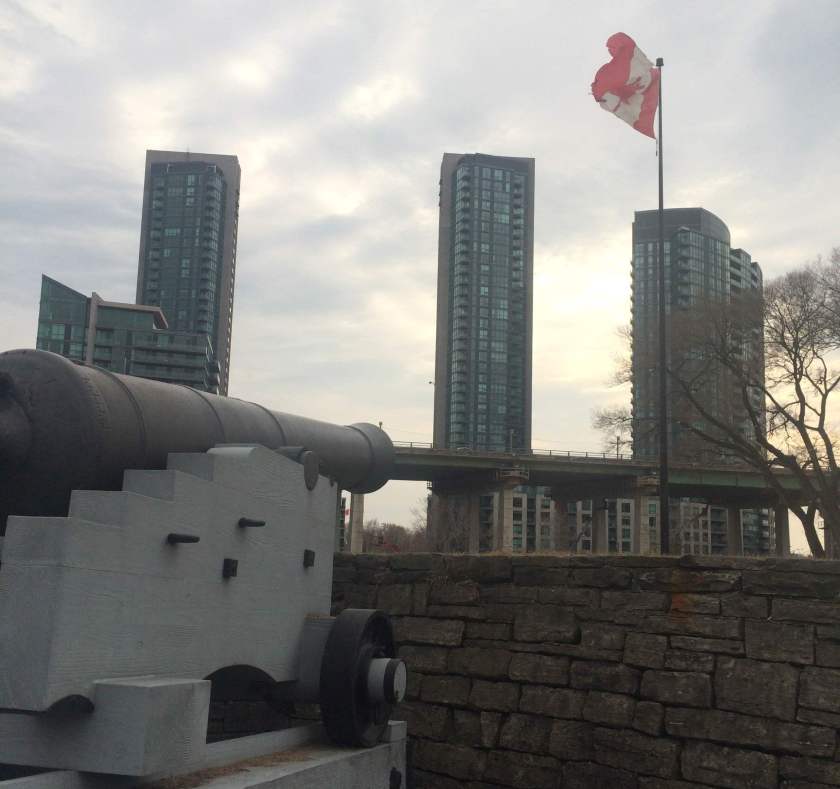
Besieged by condos, expressionless buildings and the imposing Gardiner Expressway, is Fort York. The former military site was first constructed in the late 18th century as a way to help defend the then capital city of Upper Canada, York, against attack from any would-be invaders. Today, Fort York is a museum and an historic site; but more than that, it’s an important link between Toronto, the mega-city of today and York, the small colonial outpost of the past.
Fort York is an impressive site that has an interesting past. It hosts Canada’s largest collection of original ‘War of 1812’ buildings and was a battleground in that war in 1813. Located in downtown Toronto, near the shores of Lake Ontario, the Fort is open year-round and offers tours, exhibits, and demonstrations.
York, in the name Fort York, was originally bestowed upon the settlement of Toronto by the British. The British commander in the area at the time, Lieutenant Governor of Upper Canada, John Graves Simcoe, had to relocate the capital away from Niagara for defensive reasons and didn’t like the sound of the native name of Toronto. Instead, Simcoe decided to name the settlement in honour of the young Duke of York in England.
In the early days, Canada and the U.S were anything but the friendly neighbors they are today. The North America of today was born out of gunpowder, steel and continually shifting borders.
Skirmishes and scares of all-out war were frequent over the years. Then in 1812, war finally erupted between the United States, Britain and by extension, Canada. The world was a tumultuous place at the time and the conflict is often associated with the Napoleonic wars that were engulfing Europe.
While there was a Fort York site since the late 18th century, the story really starts to come alive with the War of 1812. I won’t go into all the details here, but this great three minute video explains the causes:
As part of the war, on April 27, 1813, 1,700 U.S. soldiers sailed up Lake Ontario, landed near the Fort and began to make their way towards York. Notably, a force of Ojibwa warriors met the soldiers and battled bravery before the Americans advanced.
As the Americans advanced on the Fort and the battle raged, the cunning British and Canadian defenders retreated while lighting the gunpowder storehouse on fire behind them. The ensuing explosion wiped out 38 American troops, injured 200 and killed their commander, General Zebulon Pike (a storied and interesting character himself).
The victorious American invaders went on to occupy York for six days, loot buildings and burn the town, along with the Parliament Buildings of Upper Canada which were located at modern-day Parliament Street in Toronto.
Interestingly, this action by the Americans at York would later prompt the British to burn the White House after they successfully invaded Washington, D.C, in 1814.

Fort York is an important part of Canadian history. The site is a strong link back to the country’s colonial past and has an interesting role to play in the formation of modern day North America.
The Fort itself remained in use for many years after the War of 1812 and has continued to be an important historic feature in the city of Toronto right up the present day.
I visited the Fort during winter and did not take a guided tour. I’d recommend calling in advance to ensure that you have a guided tour so you can get the full experience. During the summer months, the site is a lively place and “comes alive pageantry of the Fort York Guard”. Overall, the Fort offers an interesting insight into colonial history.
Entry: $9 (CAD) for adults; $5.50 for seniors (65+); $5.50 for youth (13–18 yrs.); $4.25 for Children (6–12 yrs.); and, free for children under 5 years.
